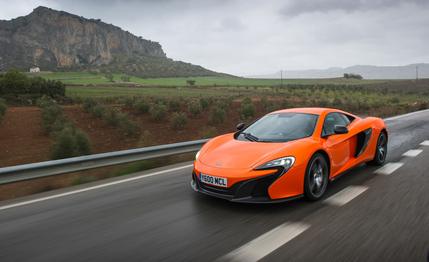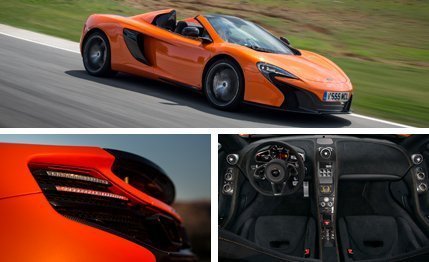 First Drive Review
First Drive Review
Turning off the stability control in a 641-hp, rear-wheel-drive supercar with summer tires in wet, sloppy weather on a 3.4-mile, 26-turn track can be a little nerve-wracking, but that’s what is about to happen as we enter our third lap of the Ascari racetrack in southern Spain. We’re at the helm of the new McLaren 650S, and at our right is McLaren test driver Gareth Howell, who doesn’t seem to be nervous at all as he switches the Powertrain and ProActive Chassis Control (PCC) systems from their Sport to Track settings. He clearly knows something we don’t.
Here’s what he knows: Even in this foul weather, the 650S becomes more stable and more controllable the less the stability controls are activated. Why? Because you feel everything in the 650S—through the steering wheel, the seat of your pants, the firm brake pedal. Indeed, few cars communicate each individual wheel’s amount of grip with such clarity. The 650S tells you in no uncertain terms when the driver is approaching his own limits—or more accurately, when it’s approaching the driver’s limits—and the more times we lapped Ascari, the higher the limits seemed to get. The 650S is a patient teacher, always at your level, and it allows you to climb its learning curve quickly and happily.

Introduced in February prior to the Geneva auto show, the $269,200 650S coupe and the $283,925 650S spider are essentially face-lifted versions of the 12C supercar. The 12C was already good: It beat the Ferrari 458 Italia and Porsche GT2 RS in a three-way comparo shortly after its introduction in 2011. Yet in that test, as on subsequent drives, we had a few notable complaints: banal styling, a ho-hum exhaust note, and a general lack of smoothness, thanks to grabby carbon-ceramic brakes and the seven-speed dual-clutch transmission.
P1 Inspired
The 650S slots in just above the $241,900 12C and contains 25-percent-new components but doesn’t outright replace the less-expensive car. The most apparent differences are the revised styling bits. Inspired by McLaren’s spectacular $1.2 million P1 hybrid super-supercar, the 650S’s front end appears infinitely meaner than the benign 12C’s, with a sculpted front bumper and serpentine grille that features a thin band of LED-based combination headlamps evocative of McLaren’s swoosh-shaped logo. Most body panels are shared with the 12C, but plenty of new stuff is attached to them, including carbon-fiber lower door blades, gaping side scoops to feed the hungry engine, and a recalibrated dynamic rear wing that, along with the new visage, is said to contribute to a 24-percent increase in downforce at 150 mph. McLaren credits the aero-sculpted nose cone for providing better high-speed turn-in.
The 650S derives its name from the 650-PS European horsepower rating (equivalent to 641 SAE net horsepower) of its twin-turbocharged 3.8-liter V-8, up from 616 horsepower in the 12C. Torque has welled to 500 lb-ft from 443 in the 12C. The added power comes courtesy of new pistons and heads, revised cam timing, new exhaust valves, and a new exhaust system. Other changes include firming up all three PCC settings, making carbon-ceramic brakes standard, stiffening the springs 22 percent in front and 37 in back, and mounting forged 19-inch-front and 20-inch-rear wheels wrapped in Pirelli P Zero Corsa rubber.